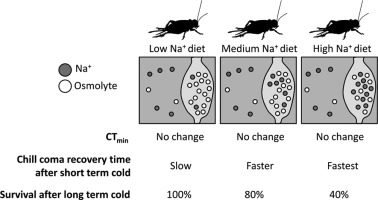当前位置:
X-MOL 学术
›
Comp. Biochem. Physiol. A Mol. Integr. Physiol.
›
论文详情
Our official English website, www.x-mol.net, welcomes your
feedback! (Note: you will need to create a separate account there.)
Reversing sodium differentials between the hemolymph and hindgut speeds chill coma recovery but reduces survival in the fall field cricket, Gryllus pennsylvanicus.
Comparative Biochemistry and Physiology A: Molecular & Integrative Physiology ( IF 2.1 ) Pub Date : 2020-04-01 , DOI: 10.1016/j.cbpa.2020.110699 Jacqueline E Lebenzon 1 , Lauren E Des Marteaux 1 , Brent J Sinclair 1
Comparative Biochemistry and Physiology A: Molecular & Integrative Physiology ( IF 2.1 ) Pub Date : 2020-04-01 , DOI: 10.1016/j.cbpa.2020.110699 Jacqueline E Lebenzon 1 , Lauren E Des Marteaux 1 , Brent J Sinclair 1
Affiliation

|
Chill-susceptible insects enter the reversible state of chill coma at their critical thermal minimum (CTmin). During chill coma, movement of Na+ and water from the hemolymph to the gut lumen disrupt ion and water balance. Recovery from cold exposure requires re-establishment of this balance, and failure to do so results in chilling injury or death. We hypothesized that the passive leak of Na+ and consequently water during cold exposure is driven by the [Na+] differential between the gut and hemolymph. To determine the extent to which this [Na+] differential affects cold tolerance, we used artificial diets to load the guts of fall field crickets (Gryllus pennsylvanicus) with various concentrations of Na+. Manipulating [Na+] differentials had no effect on the CTmin, agreeing with recent studies demonstrating that chill coma onset precedes loss of ion balance in the cold. A high [Na+] diet reversed the direction of the [Na+] differential between the gut and hemolymph. Crickets fed a high [Na+] diet recovered from 12 h of chill coma nearly twice as fast as those fed low [Na+] diets. However, the high [Na+] diet was detrimental to survival after prolonged cold exposure (three days at 0 °C). Therefore, while a reduced [Na+] differential helps crickets recover from short-term cold exposure, an increased gut Na+ load itself appears to carry longer-term costs and promotes irreversible chilling injury.
中文翻译:

逆转血淋巴和后肠之间的钠差异可加快寒冷昏迷的恢复速度,但会降低秋季田Gryllus pennsylvanicus的存活率。
对寒冷敏感的昆虫会在其临界热最小值(CTmin)进入冷昏迷的可逆状态。在寒冷昏迷期间,Na +和水从血淋巴到肠腔的运动破坏了离子和水的平衡。要从冷暴露中恢复过来,就需要重新建立这种平衡,否则,将导致冻伤或死亡。我们假设,冷暴露期间Na +的被动泄漏以及相应的水分泄漏是由肠道和血淋巴之间的[Na +]差异驱动的。为了确定这种[Na +]差异影响耐寒性的程度,我们使用人工饮食在秋季田(Gryllus pennsylvanicus)的肠内装载了各种浓度的Na +。操纵[Na +]差异对CTmin无影响,同意最近的研究,该研究表明在寒冷时冷昏迷的发作先于离子平衡的丧失。高[Na +]饮食会逆转肠道和血淋巴之间[Na +]差异的方向。12饲喂高[Na +]日粮可从12小时的寒冷昏迷中恢复,其速度几乎是fed饲低[Na +]日粮的those的两倍。但是,高[Na +]饮食对长时间的冷暴露(在0°C下需要三天)不利于生存。因此,虽然减少的[Na +]差异有助于从短期的冷暴露中恢复过来,但肠道中Na +负荷的增加本身似乎要承担长期的费用并加剧不可逆的冷害。12饲喂高[Na +]日粮可从12小时的寒冷昏迷中恢复,其速度几乎是fed饲低[Na +]日粮的those的两倍。但是,高[Na +]饮食对长时间的冷暴露(在0°C下需要三天)不利于生存。因此,虽然减少的[Na +]差异有助于从短期的冷暴露中恢复过来,但肠道中Na +负荷的增加本身似乎要承担长期的费用并加剧不可逆的冷害。12饲喂高[Na +]日粮可从12小时的寒冷昏迷中恢复,其速度几乎是fed饲低[Na +]日粮的those的两倍。但是,高[Na +]饮食对长时间的冷暴露(在0°C下需要三天)不利于生存。因此,虽然减少的[Na +]差异有助于从短期的冷暴露中恢复过来,但肠道中Na +负荷的增加本身似乎要承担长期的费用并加剧不可逆的冷害。
更新日期:2020-04-03
中文翻译:

逆转血淋巴和后肠之间的钠差异可加快寒冷昏迷的恢复速度,但会降低秋季田Gryllus pennsylvanicus的存活率。
对寒冷敏感的昆虫会在其临界热最小值(CTmin)进入冷昏迷的可逆状态。在寒冷昏迷期间,Na +和水从血淋巴到肠腔的运动破坏了离子和水的平衡。要从冷暴露中恢复过来,就需要重新建立这种平衡,否则,将导致冻伤或死亡。我们假设,冷暴露期间Na +的被动泄漏以及相应的水分泄漏是由肠道和血淋巴之间的[Na +]差异驱动的。为了确定这种[Na +]差异影响耐寒性的程度,我们使用人工饮食在秋季田(Gryllus pennsylvanicus)的肠内装载了各种浓度的Na +。操纵[Na +]差异对CTmin无影响,同意最近的研究,该研究表明在寒冷时冷昏迷的发作先于离子平衡的丧失。高[Na +]饮食会逆转肠道和血淋巴之间[Na +]差异的方向。12饲喂高[Na +]日粮可从12小时的寒冷昏迷中恢复,其速度几乎是fed饲低[Na +]日粮的those的两倍。但是,高[Na +]饮食对长时间的冷暴露(在0°C下需要三天)不利于生存。因此,虽然减少的[Na +]差异有助于从短期的冷暴露中恢复过来,但肠道中Na +负荷的增加本身似乎要承担长期的费用并加剧不可逆的冷害。12饲喂高[Na +]日粮可从12小时的寒冷昏迷中恢复,其速度几乎是fed饲低[Na +]日粮的those的两倍。但是,高[Na +]饮食对长时间的冷暴露(在0°C下需要三天)不利于生存。因此,虽然减少的[Na +]差异有助于从短期的冷暴露中恢复过来,但肠道中Na +负荷的增加本身似乎要承担长期的费用并加剧不可逆的冷害。12饲喂高[Na +]日粮可从12小时的寒冷昏迷中恢复,其速度几乎是fed饲低[Na +]日粮的those的两倍。但是,高[Na +]饮食对长时间的冷暴露(在0°C下需要三天)不利于生存。因此,虽然减少的[Na +]差异有助于从短期的冷暴露中恢复过来,但肠道中Na +负荷的增加本身似乎要承担长期的费用并加剧不可逆的冷害。











































 京公网安备 11010802027423号
京公网安备 11010802027423号